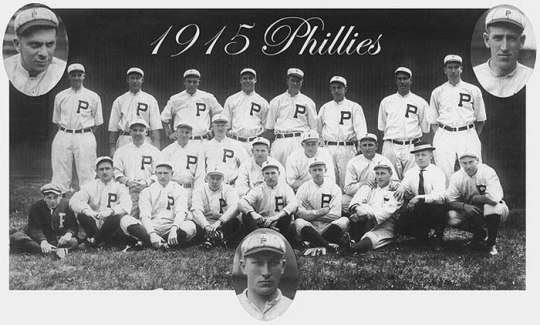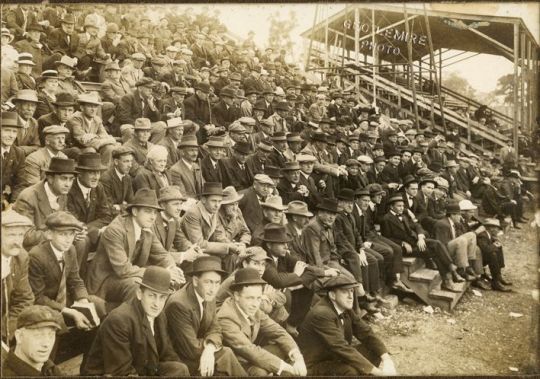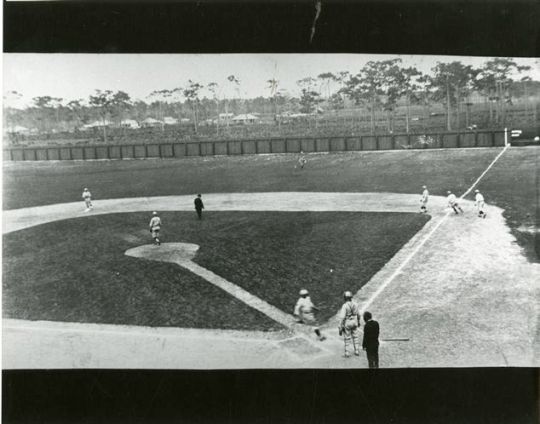Tagged: spring training florida
How Baseball Helped The Masters Become a Top Golf Tournament
The Masters became a nearly-instant success because of major league baseball. Of course baseball and golf have been long connected. A ballplayer swinging a club is more common a photo than a golfer in a batting cage, but not by much. When I worked for a baseball team, the manager and coaches would make sure there was room for their clubs in the bus every trip, and a road trip that didn’t include a few rounds was a failed road trip, no matter how the ballclub fared. When asked by his friend Ted Williams to explain the difference between hitting a baseball and hitting a golf ball, Sam Snead said golf was harder because “golfers have to play their foul balls.”
Snead was an honorary starter at the Masters for nearly 20 years, an event he won three times. By the time he won his first Masters in 1949 the event had only been around 15 years yet was already one of the premier golf events in the world. Its quick growth was due to the intelligence of Augusta National Golf Club’s co-founder, the great Bobby Jones, and his business and media vision.
As the only man to win golf’s Grand Slam in one year (although, since The Masters didn’t exist, the Slam consisted of winning the British Amateur and Open titles and the US Open and Amateur titles, which he did in 1930), Jones was followed extensively by the media while a player. When building Augusta National with Clifford Roberts and designer Alister Mackenzie in the middle of the Great Depression, they realized that a tournament would help the fledgling club in many ways. Jones asked the PGA for permission to hold a U.S. Open, but the request was denied because Georgia is kind of a hot and humid place in the summer, not the ideal conditions for a golf tournament.
So Jones and Roberts decided to create their own tournament, and asked several golf friends to play in it, thus from the beginning it was an “invitational-only” tournament. Jones also wanted media coverage of the tournament. He knew that newspapers would be likely to show up just because it was a Bobby Jones Tournament. Roberts convinced him that if he played in it, it would result in even more attention. If the biggest golf star today retired, built his own course, started a tournament there and came out of retirement to play in it, you bet the media would show up in droves. Same idea in the 1930’s with Bobby Jones.
But unlike today, transportation was difficult. It took several days to take the train across the country (it still does) and air travel was in its infancy. Somebody at Augusta National realized that after covering spring training in Florida, all the baseball writers would be heading north through Georgia at the end of March and beginning of April in preparation for Opening Day. Remember, at the time the Major League season did not start until mid-April, and the teams often barnstormed their way up north, meaning there was about a two- or three- week break between the end of spring training and the beginning of the season.
Jones and Roberts therefore decided to hold their new tournament during that two-week break, while the writers were all heading north on the train from Florida to New York and Boston and St. Louis and Chicago and Philadelphia and Detroit and Cincinnati and Pittsburgh and Cleveland and Washington, D.C. It would be easy for all the top sportswriters in America to get off the train and cover “The Augusta National Invitational,” as it was known until 1940. And they did, although in the first playing of 1934 it was because of Jones and not the tournament. But still, they wrote about it. As a result, golfers wanted to be invited to the next year’s playing, if only to play with Jones, and people wanted to know about it.
The 1935 tournament helped The Invitational gain traction as an event independent of Jones. That’s because of Gene Sarazen’s double-eagle on 15- only three have been made during the tournament since- in the final round to tie him with Craig Wood, and the resulting 36-hole playoff, which Sarazen won by five strokes. It was extensively chronicled by the sportswriters and helped immensely in the aura of the tournament. The double-eagle became known as “the shot heard ‘round the world,” (because the media likes to make sports events bigger than life) and in golf circles it still is, although most people think of baseball and Bobby Thomson when it comes to “the shot heard ‘round the world.” If you want to get historical about it, the assassination of Archduke Ferdinand and Sophie in July 1914 is also known as “the shot heard ‘round the world,” for the small conflict that happened as result of it, and the phrase is also given to the first battles of the American Revolution at Lexington and Concord. Among other things.
It may have been intended as a one-year thing, but it quickly became obvious that Bobby Jones’ tournament was a money-maker. Jones and Roberts had the course re-done extensively in the early years to make sure that golfers and sportswriters would keep coming back. The back nine and front nine were flipped beginning with the 1935 tournament, and remain so to this day. Can you imagine Amen Corner being holes three through five instead of 11 to 13?
In a large part, the tournament has baseball and spring training to thank for its early popularity. Although Sarazen only won the 1935 edition, for many years he was an honorary starter at Augusta, partnered with Sam Snead. Golfers may have to play their foul balls but there are few better places, if any, to hit them than at Augusta National Golf Course, especially in early April.
photos courtesy: golfdigest.com, atlantahistorycenter.com, pnj.com
100 Years Ago The Philadelphia Phillies Made Spring Training
 In 1915 the Philadelphia Phillies assuredly did not invent spring training, just like The Beatles didn’t invent rock’n’roll, Henry Ford didn’t invent the car or the assembly line, and Michelangelo didn’t invent sculpting. But just like “Love Me Do,” the Model T, and David, the Philadelphia Phillies 1915 spring training fundamentally changed things.
In 1915 the Philadelphia Phillies assuredly did not invent spring training, just like The Beatles didn’t invent rock’n’roll, Henry Ford didn’t invent the car or the assembly line, and Michelangelo didn’t invent sculpting. But just like “Love Me Do,” the Model T, and David, the Philadelphia Phillies 1915 spring training fundamentally changed things.
Spring training had existed for nearly 50 years in nascent forms. The first evidence of a team going somewhere warmer to practice, not surprisingly, occurs in 1870 when the first two pro teams- the Cincinnati Red Stockings and Chicago White Stockings– went to New Orleans.
The first team to spend a recognizable part of time in Florida was the Washington Statesmen in 1888, who went to Jacksonville for about a week. That club finished 37 and a half games out of first place, blamed most of it on Florida, and didn’t come back. It should be noted that was the second-best season the Statesmen ever had. The four-year NL franchise went 163-337 with a .326 winning percentage, so blaming their ills on spring training was something akin to the story of the pot and the kettle.
The first complete spring training in one location was orchestrated in 1903 by a former catcher on that 1888 Washington team who was now a manager in the upstart American League looking for an edge. Connie Mack took the Philadelphia A’s to Jacksonville as well, but when the A’s finished up 14 and a half games behind the eventual first-ever World Series Champion Boston Americans, Mack blamed it on the warmth of Florida.
The business of baseball and Florida as a tourism destination continued to grow on two separate paths. Finally, 10 years after the A’s time in Jacksonville, according to the excellent history on FloridaGrapefruitLeague.com, the Mayor of Tampa essentially bribed the former White Stockings and now Cubs to come to Florida in 1913, promising to cover $100 in expenses per player. The next year, the A’s, defending World Champs, returned to Jacksonville and this time won the pennant.
St. Petersburg, trying to one-up its neighbor Tampa, made the biggest move for ballclubs at this time, convincing the St. Louis Browns to show up for 1914 spring ball by not only also promising to cover expenses, but building the Browns a five-thousand seat stadium. Like baseball legends go, it was built, and they came.
However the Browns- and then-GM Branch Rickey– got into a dispute with St. Petersburg officials about just how many of the teams expenses were actually covered by the city. (I’m just going to go out on a limb here and guess it had something to do with alcohol, food, and cigars.) The Browns, as a result, refused to come back for the 1915 season, leaving St. Pete with a new five thousand seat stadium and nobody to play in it.
Here’s where the Phillies come in. The second team in Philadelphia because of the success of the A’s and never having won a pennant despite being National League members since 1883, they were desperate for a change in fortunes. Seeing the A’s train in Jacksonville and then win the pennant and also knowing that St. Pete had new and now empty facilities likely caused the Phillies to become the new tenants for 1915.
Not much attention was paid to the Phils during preseason camp. They had finished second in 1913, their highest finish since 1901, but a sixth-place finish in 1914 seemed to indicate that the Phils had slipped back to the norm. But when they opened the 1915 season by winning eight straight and 11 of their first 12, both the city of St. Pete and the Phils were quick to point to the Florida training. The city probably was a little louder about it than the Phillies were. The club was at least tied for first place from July 13th on and won their first pennant by six and a half games.
Would Florida eventually have become the go-to place for spring training even without the 1915 Phillies? Probably, because Florida was growing as a tourist destination in the winter anyway, especially for rich team owners. Athletes were finding the place in order to train on their own and enjoy other aspects of the good life as well. But because the Phils were perennially so bad and in 1915 they were so good, the cause-and-effect of Florida spring training was amplified, probably mostly by mayors in Florida. Perhaps the best example is the Boston Braves, the Miracle 1914 team who finished second to the Phils in 1915. In 1916 the Braves became the first team to have spring training in Miami, and that cannot be any sort of coincidence. By the mid-1920’s 10 of the 16 Major League clubs were in Florida for spring training on at least a part-time basis.
Despite staying in St. Pete for three more seasons, the Phils weren’t able to duplicate the success of 1915. In 1916 they finished 2.5 games back of Brooklyn, who called Daytona Beach home, in 1916 and second to the Marlin Springs, Texas-trained New York Giants in 1917. (Philly then didn’t sniff success until coming out of nowhere again and winning the pennant in 1950, after they’d settled for good in Clearwater.) It probably didn’t hurt that Hall of Famer Grover Cleveland Alexander had a season for the ages on the hill in 1915, going 31-10 with a 1.22 ERA and a career-high 241 strikeouts for an MLB-high 10.4 WAR. Outfielder Gavvy Gravath set a then-modern MLB-record with 24 homers in a single season and had one of his best statistical years as well.
A final note on Florida spring training- the first team to spend a full preseason in the Sunshine State and then win the World Series was a descendant of the very first team to spend any time in Florida- the American League Washington Senators, who went to Tampa in 1924. By then going south for spring training was as sure as the change of seasons, and the next frontier was the west. Although the Cubs were the first team to go to California in 1903 and were training on Santa Catalina Island outside of L.A. by the mid-1920’s, the Detroit Tigers were the first team to head for in Arizona in 1929. But that is a story for another day.
Sources: baseball-reference.com, FloridaGrapefruitLeague.com, SABR’s excellent Spring Training Database, tampabay.com, springtrainingonline.com, deadballbaseball.com, thedeadballera.com
Photos courtesy: thedeadballera.com, tampabay.com




